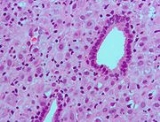
Endometrium
Overview
The endometrium is the innermost glandular layer and functions as a lining for the uterus, preventing adhesions between the opposed walls of the myometrium
, thereby maintaining the patency
of the uterine
cavity. During the menstrual cycle
or estrous cycle
, the endometrium grows to a thick, blood vessel-rich, glandular tissue layer. This represents an optimal environment for the implantation of a blastocyst
upon its arrival in the uterus.
Myometrium
The myometrium is the middle layer of the uterine wall, consisting mainly of uterine smooth muscle cells , but also of supporting stromal and vascular tissue...
, thereby maintaining the patency
Patency
-Definition:The property of being open and unobstructed, with continuity of lumen .-Examples:* An obstructed coronary artery was treated by balloon angioplasty and patency was restored....
of the uterine
Uterine
The word uterine can refer to different meanings:* relating to or near the uterus or womb* having the same mother, but different fathers, see matrilineality...
cavity. During the menstrual cycle
Menstrual cycle
The menstrual cycle is the scientific term for the physiological changes that can occur in fertile women for the purpose of sexual reproduction. This article focuses on the human menstrual cycle....
or estrous cycle
Estrous cycle
The estrous cycle comprises the recurring physiologic changes that are induced by reproductive hormones in most mammalian placental females. Estrous cycles start after puberty in sexually mature females and are interrupted by anestrous phases or pregnancies...
, the endometrium grows to a thick, blood vessel-rich, glandular tissue layer. This represents an optimal environment for the implantation of a blastocyst
Blastocyst
The blastocyst is a structure formed in the early embryogenesis of mammals, after the formation of the morula. It is a specifically mammalian example of a blastula. It possesses an inner cell mass , or embryoblast, which subsequently forms the embryo, and an outer layer of cells, or trophoblast,...
upon its arrival in the uterus.

